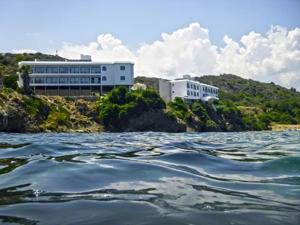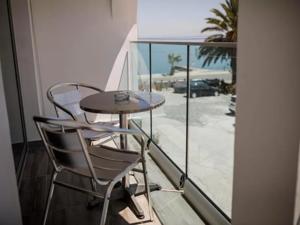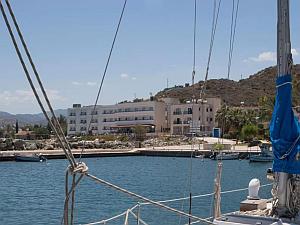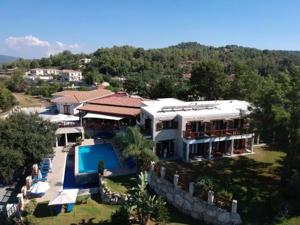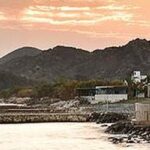
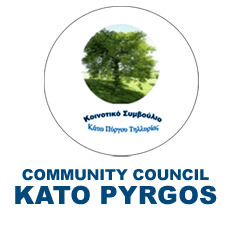 Kato Pyrgos is the main village of Tylliria. It is built on the northern foothills of the Troodos mountain region, at the largest and most beautiful valley of the area and along an incomparable crystal beach. The name of the village derived from “Troulli”, a small building resembling a tower (Pyrgos) located on an imposing beach hill of the area. In reality, “Troulli” was used as an observation post during the Venetian period, whereas renovation works have recently begun by the Department of Antiquities of Nicosia.
Kato Pyrgos is the main village of Tylliria. It is built on the northern foothills of the Troodos mountain region, at the largest and most beautiful valley of the area and along an incomparable crystal beach. The name of the village derived from “Troulli”, a small building resembling a tower (Pyrgos) located on an imposing beach hill of the area. In reality, “Troulli” was used as an observation post during the Venetian period, whereas renovation works have recently begun by the Department of Antiquities of Nicosia.
Although located in the Lefkosia (Nicosia) district, due to the Turkish invasion of 1974, the village of Kato Pyrgos is now only accessible via the Pafos (Paphos) region; reached by-following the A1 and the A6 motorways. After arriving at Pafos, take the B7, then the E704 to find the village in the heart of the beautiful area of Tylliria.
Built on the northern foothills of Troodos, the village uniquely combines coastal front with hillsides, and its surroundings of both beach and mountains – coupled with the fresh fish that comes from the fishing shelter of the village – make it a popular holiday resort.
The village is also home to the historic and significant Chapel of Panagia tis Galoktistis (Virgin Mary) which contains hagiographies dating back to the 12th and 14th centuries. Legend tells that the chapel was built with milk (‘Galoktistis’ in Greek) after the Virgin Mary answered the prayers of the villagers to heal their diseased sheep.
An old oak tree stands in the village square, dating back to 1898, and is over 20 metres high.In the nearby fields of the village, a variety of fruit is cultivated, and Pyrgos peaches are particularly famous. Kato Pyrgos is also known as one of the island’s main natural charcoal producers.
Accommodation
E.J.Pyrgos Bay Hotel
Set in Kato Pyrgos, 14 km from Vouni Palace, E.J. Pyrgos Bay Hotel offers accommodation with a restaurant, free private parking, a bar and a shared lounge. Featuring a garden, the 2-star hotel has air-conditioned rooms with free WiFi, each with a private bathroom. The hotel features family rooms. At the hotel, all rooms are fitted with a wardrobe and a flat-screen TV. Guests at E.J. Pyrgos Bay Hotel can enjoy a buffet breakfast. The accommodation offers a terrace. Guests at E.J. Pyrgos Bay Hotel will be able to enjoy activities in and around Kato Pyrgos, like cycling. The nearest airport is Paphos International Airport, 55 km from the hotel.Tylos Beach Hotel
The family-run Tylos Beach Hotel is located in the small village of Kato Pyrgos. It boasts a private beach area and air-conditioned rooms overlooking the mountain or the sea.
Fitted with floor-to ceiling windows, the bright guestrooms feature a flat-screen TV and seating area. Each opens out onto a balcony.
A Continental breakfast is served daily. The on-site restaurant offers local Cypriot dishes. Room service is also available.
Tylos Beach Hotel is 28 km from the Baths of Aphrodite and 35 km from Akamas National Park. Wi-Fi is free in public areas on the property. Private parking is complimentary and can be found on site.
Michaelides Apartment
Located 13 km from Vouni Palace, Michaelides Apartments provides accommodation with free WiFi and free private parking. All units feature air conditioning and a flat-screen TV.Demetriou Paradisos Hills Hotel – Lyso (24km from Kato Pyrgos)
Nestled on the edge of a forest, this traditional Cypriot stone house offers private balconies overlooking the Troodos Mountains or Mediterranean Sea. It has an outdoor pool and a peaceful garden. Demetriou Paradisos provides air-conditioned rooms with satellite TV and minibars. Each spacious room comes with a tiled floor and a private bathroom. Cypriot and international cuisine can be enjoyed on the panoramic terrace and there is a well stocked bar for after-meal drinks. Cooking classes can be arranged for an extra charge.Kato Pyrgos in the heart of the stunning Tylliria area, combines beaches with crystal clear waters and beautiful hillsides.
As few know, Nicosia has beautiful pebble beaches in the charming and remote village of Kato Pyrgos Tyllirias, at a distance of 111km away from the Nicosia city centre. The village, which also operates a fishing shelter, is built on the northern foothills of the Troodos mountains and combines a unique coastal front with green hillsides, making it particularly attractive to holidaymakers. The name of the village derives from “Troulli”, a small building resembling a tower (Pyrgos) located on a hill above the beach in the area. The stone-built tower was used as an observation point during the Venetian period. The longest route to the village from Nicosia, is through Paphos, but it’s worth the drive, as the scenery from Argaka village to Kato Pyrgos is breathtaking – a mesmerising combination of the deep blue sea surrounded by lush green fields.
The most popular beaches in this area are called “Krioneri” (cold water), “Omega” (due to the shape of the coastline – like the Greek letter – Ω) and “Apothikes” (warehouse). Apothikes is a sandy beach named after a building located nearby that used to operate as a warehouse in the 1920s. There are sun beds and umbrellas for rent, and a few restaurants and taverns nearby. Krioneri beach was named after the cold waters of the sea. There are some colourful sun beds here that belong to the “Grape by the Sea” beach bar where you can enjoy refreshing drinks and dishes such as steaks, sandwiches and burgers. It’s open all day from 10am until late at night. A small part of Krioneri beach allows for swimming with dogs. The beaches are surrounded by hillsides, greenery and wild nature, with pine trees, peach trees and lemon trees blending seamlessly with the majestic views of the sea.
With just 1500 inhabitants, the village attracts a mixture of tourists and locals who want to escape the buzz of the city and the other coastal areas that gain increasing popularity during the summer months. Apart from its serene and relaxing beachside, Kato Pyrgos is also worth visiting for its historical precedence – one of its old churches, the historic Chapel of Panagia tis Galoktistis (Virgin Mary), features murals of saints dating back to the 12th and 14th centuries. According to legend, the chapel was built with milk, hence its Greek name “Galoktistis”, after the Virgin Mary answered the prayers of the villagers to heal their ailing sheep. At the village square you will find a 20-metre tall oak tree dating back to 1898. The village is also known for cultivating fresh fruit, such as peaches, oranges, lemons and mandarins.

